#HistoryoftheWorld
Text
1206 - 1227 - In 1206, Genghis Khan was accepted as the leader of the Eastern Steppe tribes and all societies in the known world started becoming targets for the Mongols. Genghis Khan was very successful, but why was this?
#genghis khan#mongolia#kurultai#mongols#china#chinahistory#iran#khwarazm#uzbekistan#history#historyoftheworld#worldhistory#medievalhistory
0 notes
Text
tvrundown USA 2023.03.07
Tuesday, March 7th:
(exclusive):
"History of the World, Part II" (hulu, day 2, next 2 eps),
"Who Killed Robert Wone?" (Peacock, 2-part docu-series)
(streaming weekly):
How I Met Your Father (hulu)
(hour 1):
The Winchesters (theCW, season 1 finale),
"9-1-1: Lone Star" (FOX),
Night Court (NBC) /
/ American Auto (NBC)
(hour 2):
Accused (FOX),
The Voice (NBC, 2nd timeslot opener),
The Oval (BET, penultimate),
Superchef Grudge Match (FOOD),
Love Trip: Paris (Freeform, 2hrs)
(hour 3):
That's My Jam (NBC, season 2 opener, new night/timeslot),
Tyler Perry's "Ruthless" (BET, season 2 finale),
History's Greatest Heists (HIST),
Love Trip: Paris (Freeform, contd, season 1 finale),
True Lies (CBS, reair of series premiere)
(hour 4 - latenight):
That Dirty Black Bag (AMC, ~67mins, penultimate)
[repeats, resuming next week:
FBI (CBS),
FBI: International (CBS),
FBI: Most Wanted (CBS, preempted) ]
[resuming in two weeks:
The Rookie (ABC, repeat),
The Rookie: Feds (ABC, preempted),
Will Trent (ABC, two repeats) ]
0 notes
Video
vimeo
HISTORY OF THE WORLD PT 2 | “THE GAME” | CREATIVE DIRECTOR | PROD: HULU CREATIVE + MEDIA MONKS
0 notes
Text

Spotted 😊
17 notes
·
View notes
Video
youtube
Liberation of Netherlands and Jews From Camps Have We Learned Nothing? Liberation of Netherlands and Jews From Camps 1944-1945 - The Canadian Involvement - Have we learned nothing from history? It must be stopped! #Netherlands #Concentrationcamps #transitcamps #Denmark #Germans #history #CanadianHistory #military #humanity #Holocaust #1944 #1945 #germanoccupation #learnfromhistory #abetterworld #stopviolence #stopwars #militaryhistory #Liberation #LiberationofNetherlands #Canada #Education #learning #travel #international #CanadianTravelling #Travel #peace #respect #appreciation #WWII #historyoftheworld #historicevents #wemustdobetter #savelives
#youtube#Liberation of Netherlands and Jews From Camps 1944-1945 - The Canadian Involvement - Have we learned nothing from history? It must be stoppe
0 notes
Text
Watch "Insane History Facts You Weren't Taught In School #history #shorts" on YouTube
0 notes
Text
I'm glad that it wasn't just my reaction to that clip. The dialogue is even similar.#somethingrotten #historyoftheworld
https://www.broadwayworld.com/article/SOMETHING-ROTTEN-Writer-Says-Mel-Brooks-Ripped-Them-Off-With-HISTORY-OF-THE-WORLD-PART-II-Scene-20230208
0 notes
Photo

Heh. @sarayublue @kumailn and I had some fun. And look at all these funny friends fooling about as well. Xoxo #melbrooks who knew?!? A sequel 40 years in the making, Mel Brooks' History of the World PART II 🌍 A four night event, streaming March 6 on Hulu. #HistoryOfTheWorldPart2 @historyoftheworld (at KamaSutra) https://www.instagram.com/p/CoVnn3cPHZ8/?igshid=NGJjMDIxMWI=
0 notes
Video
youtube
“Jesus…” “Yes” “What?”
#MelBrooks, #HistoryoftheWorld, John Hurt as Jesus.
*One of my fave comedy bits f/ the film.
Birthday Remembrances. Today, Jan 22, 1940 – #JohnHurt, English actor (d. 2017) was born.(https://en.wikipedia.org/wiki/John_Hurt)
0 notes
Photo

*#GodisOne #shemayisrael #oneLORD #YahwehisOne #historyoftheworld* http://ChristianityOriginal.com/Almighty One of the teachers of the law asked Jesus, “Of all the commandments, which is the most important?” “The most important one,” answered Jesus, “is this: 'Hear, O Israel: *Yahweh, our God, Yahweh is one.* Love Yahweh, your God with all your heart and with all your soul and with all your mind and with all your strength.' The second is this: 'Love your neighbor as yourself.' There is no commandment greater than these.” “Well said, teacher,” the man replied. “You are right in saying that *God is one* and there is no other but him." Mark 12:28-32 Meme idea credit: CO Fan Stănică Eduard https://www.facebook.com/ChristianityOriginal/photos/a.763724020337694/6004525729590804/?type=3
0 notes
Text
1162 - 1206 - This is actually the story of Temüjin, a young boy born of noble stock, and outcast following his father's death. We track Temüjin's incredible rise from humility to grandeur, and find out how he become Genghis Khan.
#genghis khan#mongol empire#khentii#mongolia#temujin#borjigin#history#medievalhistory#historyoftheworld#worldhistory
0 notes
Photo

Finis Libri Secundi. The History of the World (1628) by Sir Walter Raleigh #sirwalterraleigh #finisfriday #historyoftheworld (go see the maps over at @bbrarebooks) (at B & B Rare Books, Ltd.) https://www.instagram.com/p/CcbDh-iJRAB/?igshid=NGJjMDIxMWI=
64 notes
·
View notes
Text
Lost history of Bhutan
After the Second First Battle of Simtokha Dzong, where the campaign of the Tibetan forces were defeated by several chieftains of Bhutan supporting the Zhabdrung Ngawang Namgyal who was also known as ‘the bearded lama’ and the victory over the invasion of the Mongol leader Gushi Khan in 1644 who invaded Bhutan with a vast army who invaded again in 1647, and was again defeated. Namgyal set about establishing a system of government and laws for the country and unifying Bhutan. The country was divided into regions, which were administered by governors known as Penlops, with Dzongpons appointed below them to administer civil affairs locally.
But after the death of the Zhabdrung in 1651, it is believed that the death of the Zhabdrung was kept quiet for 50 years so that a legitimate successor might be found. This system presented few problems in the first few years, but gradually, power devolved into the office of the Druk Desi, and local civil wars ensued. The two seeds of the problem were that the system of choosing successive Zhabdrung was reincarnation, and that as the successor was chosen at birth, for the first 18 years of his birth he was a minor, and power again devolved onto the Druk Desi. Successive Druk Desis proved reluctant to part with their acquired power, and the power of the Zhabdrung gradually waned. Namgyal's efforts at establishing central authority were gradually wasted as the Druk Desi lost control to the regional governors and the Penlops. The country degenerated into a series of semi-independent regions, each controlled by a Penlop. During such wars among the local chieftains and royals two family Dunghkar(Royals) and Ebi/Ubi/Ribi(Royal Guards) left their controlled region and palaces after their defeat to save themselves and to regroup themselves for a future attack.
Leaving Bhutan for ‘Sun’s nest in the east’, these two clans who left Bhutan in the 17th century never returned back and are believed to have settled in present day Arunachal Pradesh in India. Evidence suggest that after the civil war, the royal administration sent out delegates with several gifts and ornaments to bring back the lost families back to their regions but were denied by the tribals who had integrated them with their community in the region.
References
Ardussi (1977)
Richardson, Hugh. A Corpus of Early Tibetan Inscriptions
Stein, R. A. (1972) Tibetan Civilization
Ancient Tibet: Research Materials from The Yeshe De Project
Lee, Don Y. The History of Early Relations between China and Tibet: From Chiu t'ang-shu, a documentary survey
Muktinath Bardoloi (1970). Land of the Hornbill and Myna
#historyoftheworld#historyofbhutan#Historyofindia#historyoftibet#sherdukpen#shertukpen#arunachalpradesh#historyofarunachalpradesh#monpas#ebi#dungkhar#dunkhar
1 note
·
View note
Text

#Countries#History#Hatred#Controversy#OtherCountries#Teach#HistoryOfTheWorld#GoodValue#Humanity#Losses#Grief#War#Ancestor#GoThrough#LetGo#ThePast#HealTheWorld
1 note
·
View note
Text
Top of the World: Matthew Henson and the First Frozen Steps
By 1887 Matthew Henson thought his days of adventure were behind him. After an unconventional early life he found himself working as a shop clerk until one fateful day when a certain customer came inside the shop. By the time the customer left Henson had a new job and was on his way to the history books.
Henson was born in Charles County, Maryland on August 8th, 1866, one year after the end of the Civil War. His parents were free sharecroppers, but both died when he was very young leaving him in the care of his uncle, who also died within a matter of years. Before the age of ten Henson was orphaned, leaving him to make his way through life relying on his own wits, skills, tenacity, and courage. They served the young boy well and at the age of twelve he walked his way to Washington D.C. and signed up to be a cabin boy on the sailing ship the Katie Hines. The next six years spent on the ship were extremely beneficial for Henson and under the wing of the captain, Captain Childs, he received a thorough education on life at sea becoming a skilled sailor, developing an arsenal of technical skills, and traveling all over the world.
Given his experience, when Captain Childs died in 1887 one would have assumed that Henson would resume his life of exploration and adventure on another ship, but that was not the case. Henson found a job at a Washington D.C. clothing store and probably expected a normal, quiet life. It all changed with one customer, a naval officer named Robert Peary, who was looking to sell pelts he accumulated on his latest expedition to Greenland. The stories sparked an old fire in Henson and undoubtedly the conversation swayed to his previous life at sea. The officer was impressed by Henson’s past and immediately offered him a new job, being his personal assistant and accompanying him on his next excursion to the jungles of Nicaragua.
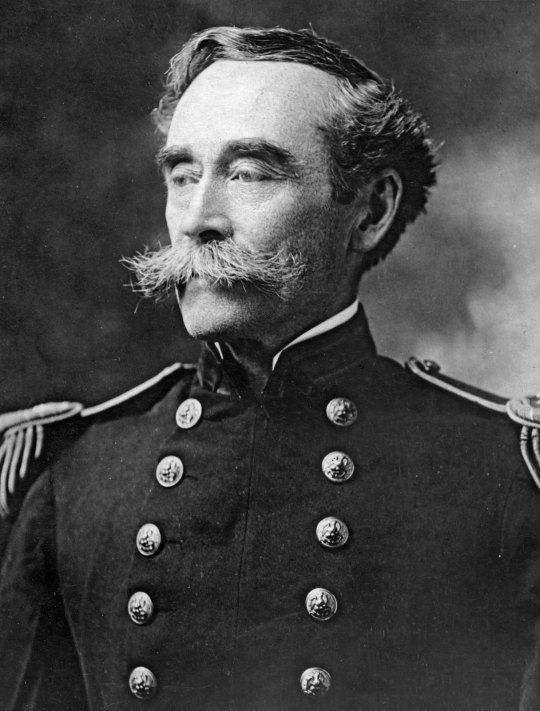
Robert Peary. Image via Britannica.com.
The trip to Nicaragua was no small undertaking for Henson and Peary, the officer’s task was to map the wilderness to find a way to connect the Atlantic and Pacific oceans with a canal. Henson’s previous experiences were hugely beneficial to the two-year long excursion and his abilities stood out among the forty-five man crew. A friendship was cemented between the two and upon their return from Central America Peary secured Henson a job as a messenger at the League Island Naval Yard in Philadelphia. Their time in Nicaragua was over but it was far from the last time the pair would explore the world together. In 1891 Peary was again heading out and wanted Henson to join him. This time it was not to the jungles of Central America, it was to the frozen expanse of Greenland.
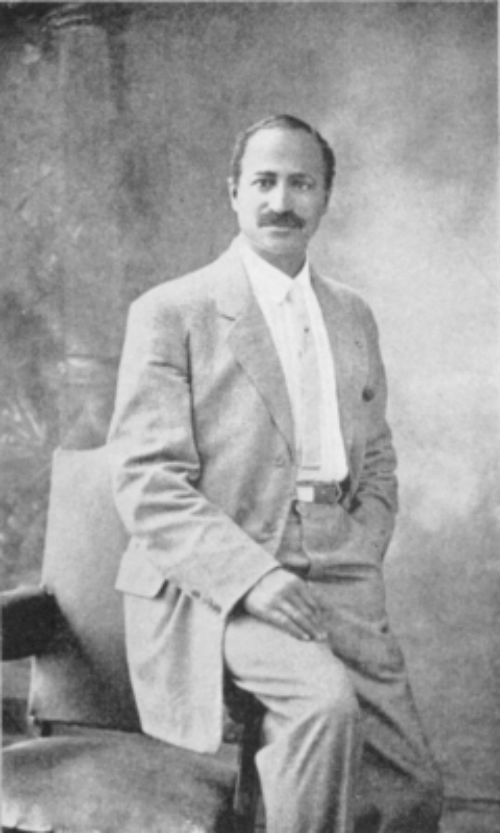
Later photograph of Matthew Henson.
When Henson and Peary set out for the top of the world it marked the beginning of an eighteen-year-long partnership that would include seven trips to the frozen tundra. Time and time again Henson proved that he was the backbone of the excursions. Upon their first trip to Greenland Henson threw himself into the Inuit culture, learning their language, trading with them, and learning their techniques for survival in the harsh atmosphere. In addition to absorbing and learning the Inuit ways of life, Henson honed and expanded his skills as a craftsman building the houses where they lived and maintaining all the sleds and equipment that were critical to their mission.
The second venture to Greenland from 1893 to 1895 barely avoided tragedy when the exploration team hit a string of bad luck that nearly caused them to starve to death. The objective of the trip was to map the entire ice cap but on their way to the northernmost corner snowfall hid their food supplies and suddenly all attempts at hunting went cold. On their return trip the explorers were forced to eat their sled dogs in order to avoid death. On the last leg of their torturous march back to base camp a member of the team, exhausted and starving, laid down in the snow and told Henson and Peary to leave him behind. Henson told them they were all making it back or none of them were making it back. Two weeks later they staggered into base camp with only one of their dogs left alive.

Matthew Henson and Robert Peary.
The harrowing experience did not deter them from going north again and in 1896 and 1897 the pair returned to Greenland, this time returning home with their hands full. On previous expeditions the explorers found three massive meteorite fragments and upon their return home with them they were sold to the American Museum of Natural History in New York for $40,000. The largest fragment, called the Cape York fragment, weighs thirty-one metric tons, is the third largest intact meteor ever discovered, and the largest ever transported by humans. The hefty sum of money would go towards funding their future excursions, and there was one particular trip they had in mind. They wanted to go where no others had gone before, they wanted to be the first to set foot in the North Pole.
The ultimate goal may have been the North Pole, but the road there would be difficult, sometimes bordering on catastrophic. Henson continued to be a vital part of the exploration using his many technical skills to advance and train the most elite members of Peary’s teams and continuing to learn the Inuit culture and language. Over time the Inuit people gave him a nickname, “Matthew the Kind One.” As incredibly skilled and well-versed in the arctic as the team was, there were some things they could not prepare for. During the 1902 expedition the path north was blocked by melting ice and their supplies ran out before they could return to base. Six of their Inuit team members died on the venture.
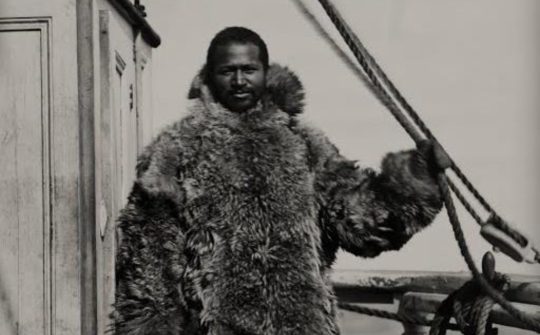
Matthew Henson.
The 1905-1906 expedition seemed backed with promise for success. Each trip brought them closer to the North Pole and this time they had support from President Theodore Roosevelt and use of a new three-masted steam-powered schooner called the Roosevelt, specifically built to travel through ice. They got within 174 miles of the North Pole, but they were again kept from their goal by melting ice. Forced to turn back Peary knew they were getting closer and wrote in his journal, “When my observations were taken they showed that we had reached 87°6′ north latitude, and had at last beaten the record, for which I thanked God.”
It was two years before Henson and Peary could once again head out to attempt the feat that had alluded them for so long and taken so many lives with it. A team was assembled including Peary, Henson, Dr. John W. Goodsell, Donald B. MacMillion, Ross G. Marvin, George Borup and Robert Bartlett, captain of the Roosevelt. The strategy was made up of many intricate parts. The team would sail to Cape Sheridan on the northern-most part of Ellesmere Island, Canada, spend several months amassing food and supplies, and then travel to Cape Columbia where they would build a base camp for the main objective of getting to the North Pole. Knowing that all of them could not travel the entire way through, the push to the pole was set up as a sort of relay with certain members of the team going as far as a specific point then caching the supplies where the next team could find them and use them to get to the next point along the path. Peary knew he was going the entire distance to the North Pole, and he knew Henson was going with him. He stated before the excursion began, “Henson must go all the way. I can't make it there without him." He was absolutely correct. During the entire endeavor Henson built the sleds, built the shelters, built igloos to cache supplies for members of the “relay” team, worked with the Inuit people, and trained people on how to handle the sled dogs. Donald MacMillon later stated that Henson “was indispensable.”
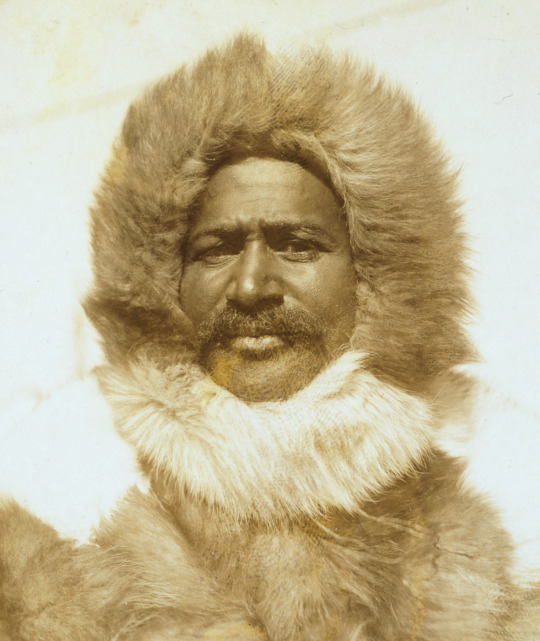
Matthew Henson.
On September 5th, 1908, the Roosevelt reached Cape Sheridan and the team began the first step of a grueling journey, surviving the winter months. Sleds were built, large numbers of musk ox, rabbit, and deer were hunted, and several Inuit members of the team had their wives and children meet them and work on making clothing that would keep them alive in an environment that could drop to over sixty degrees below zero. In February 1909 Henson and some of the Inuit traveled by sledge to Cape Columbia and began setting up base camp by building igloos and gathering supplies. It was from here that they would officially launch the attempt for the North Pole on March 1st 1909.
The entire ordeal took five weeks with teams traveling ahead of the core group of Henson, Peary, and their Inuit companions, dropping supplies for them, and turning back to all meet at the Roosevelt and hope that they would see their friends again one day. The first team to turn back and return was led by McMillan with Dr. Goodsell, followed by the Borup team, then the Marvin team, and lastly the Bartlett team. Once they all returned to the Roosevelt the captain readied the ship for the anticipated return of “The Pole Team” of Peary, Henson, and their small crew. All they could do was wait.
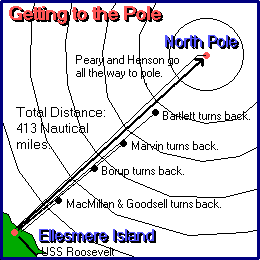
Diagram of each team and their route. Image via unmuseum.org.
For days Henson, Peary, Inuits Ooqueah, Ootah, Egingwah, Seegloo, and five dogs charged headfirst into the elements, traveling in stretches of twelve and fourteen hours in a desperate, raging attempt to get to the North Pole. Traveling 170 miles, by early April Henson was certain their end goal was near. He later wrote:
“We crawled out of our igloos and found a dense mist hanging over everything. Only at intervals, when the sun’s rays managed to penetrate the mist, could we catch even a glimpse of the sky. Estimating the distance that we had come during the last four days, we figured that, unless something unusual happened to us during the course of this day, we should be at the Pole before its close.”
On April 6th 1909 Henson was leading the pack when Peary, who was approximately fifty yards behind him, called ahead and said they should set up camp. It was misty and impossible to figure exactly where they were standing so the group went about their normal routine of building igloos, eating, and settled in to get some much needed sleep. By the next morning the mist had lifted, and Peary began to calculate their location. He was probably shocked to realize that the precise location of the geographical center of the planet lay just behind the igloos they had been sleeping in all night. The men had officially, and finally, reached the North Pole.
The mood should have been ecstatic. The men were the first to reach the top of the world, but it was the word “first” that quickly soured the astounding victory. Henson was the leader of the group as they traveled so realistically, Henson was the first man to ever walk on the North Pole. When they trekked back Henson’s footprints were clearly marking the site first. When the team turned to return to the Roosevelt there was allegedly a marked difference in the bond between Peary and Henson. As Henson later recalled:
“From the time we knew we were at the Pole, Commander Peary scarcely spoke to me…It nearly broke my heart … that he would rise in the morning and slip away on the homeward trail without rapping on the ice for me, as was the established custom.”
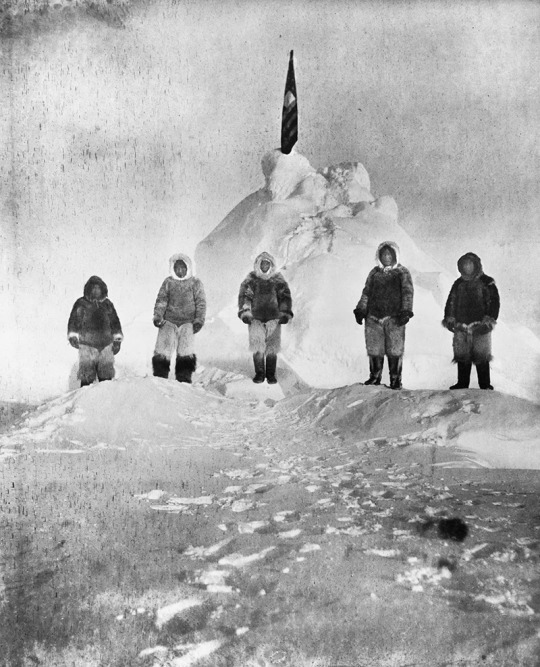
Photograph of members of the Pole Team.
If Peary was harboring bitterness toward Henson he may have secretly enjoyed the reception when the team returned home. The feat of walking on the North Pole was an astronomical, seemingly impossible human achievement, and the victory was not one that people were willing to award to the African American Matthew Henson. The praise and accolades went chiefly to Peary with Henson’s role being greatly downgraded to the important assistant to Peary. The success was not totally easy on Peary though. Amid the praise was a heavy amount of skepticism that the crew had actually reached their destination and he was required to testify before Congress that they had reached the North Pole despite a lack of indisputable proof. Another blow to the story came in the form of a man named Frederick Cook who claimed he reached the North Pole a full year before Henson, Peary, and their crew. His claims were quickly proven to be a hoax, but it still left tarnish on the massive accomplishments of Henson, Peary, and their teammates.

Newspaper featuring Peary telling the story of the expedition.
Peary was promoted to Rear Admiral and lived out the rest of his life as an acclaimed hero. The same could not be said for Henson who took a job as a clerk with the federal customs house in New York City. Unlike his time at the Washington D.C. clothing store, this time Henson was truly finished with exploring and he remained at the customs house for thirty years. He adopted a quiet life but he never forgot his pursuit of the North Pole and in 1912 he published his account of the endeavor, A Negro Explorer at the North Pole: The Autobiography of Matthew Henson.
Henson did not receive any official recognition of his vital role in the first human steps on the North Pole until 1937 when he was made an honorary member of The Explorers Club of New York at the age of seventy years old. He was presented with a Congressional medal in 1944 and in 1954 President Dwight Eisenhower invited him to the White House where he was honored for his work as an early American explorer.
Matthew Henson died in New York City on March 9th, 1955 at eighty-eight years old and he was initially buried in Woodlawn Cemetery in the Bronx. He continued to be honored after his death and on April 6th, 1988 the remains of he and his wife were relocated to Arlington National Cemetery and laid to rest with full military honors on the 79th anniversary of Henson’s first steps on the North Pole. In 2000 the National Geographic Society posthumously honored Henson with their most prestigious award of the Hubbard Medal.
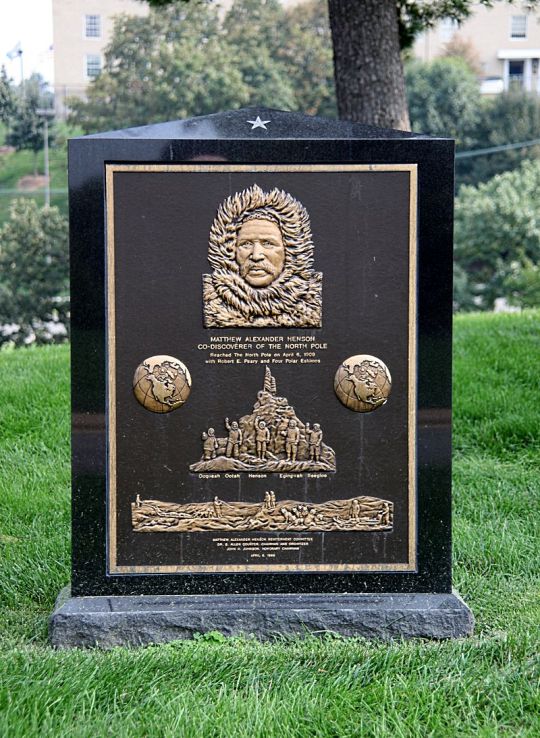
Grave of Matthew Henson in Arlington National Cemetery. Image via Wikimedia Commons.
On March 1st 1909 a team of people set out to accomplish a seemingly insurmountable task, set foot on a frozen corner of the planet where humans had never tread before. While it was a team effort that led to the steps set on the North Pole on April 6th 1909 it is undeniable that Matthew Henson was the main force in the effort. With his multitude of skills constantly accumulated and honed from a young age, his respect and utilization of Inuit culture and practices, and his unswayable courage, Henson was far from being an assistant. He was, and is, the first man to set foot on the North Pole.
********************************************************************
Sources:
The Legacy of Arctic Explorer Matthew Henson, National Geographic.com, James Mills.
Matthew Henson. Biography.com
A Negro Explorer at the North Pole: The Autobiography of Matthew Henson by Matthew Henson, 1912.
#husheduphistory#featuredarticles#history#AfricanAmericanHistory#explorer#exploration#MatthewHenson#NorthPole#firsts#TheFirstManTo#FirstSteps#famousfirsts#hero#AmericanHero#uncharted#truestory#historyiswild#historyoftheworld#historyisfun#historyisawesome#historynerd#knowhisname#tellhisstory#historyclass#amazinghistory#historyhero#ExplorationUnknown#ArcticExploration#bravery#mission
3 notes
·
View notes
Photo

NEW MAP: Europe 68: Downfall of Nero (07 Jun 68 AD) https://buff.ly/2mX0Ra2 Nero’s extravagances alienated the Roman elite, encouraging the governors Vindex and Galba to lead the Gallic and Spanish provinces in revolt in 68 AD. Although Vindex was quickly defeated by the Rhine legions, the Praetorians and Senate declared for Galba in June. Deposed and condemned, Nero committed suicide, bringing an abrupt end to the Julio-Claudian dynasty. #historyoftheworld #68 #june #ancientrome #ancient #romanlegion #galba #carta #cartografia #nero #gaul #europe #europeanhistory #ancienthistory #geopolitics #historia #historie #history #historyclass #june7 #maps #oldmaps #roman #romancivilwar #romancivilwars #romanempire #romanhistory #romans #worldhistory #newmap (at Tarraco) https://www.instagram.com/p/B24zth6gdV-/?igshid=txuol7t0hu68
#historyoftheworld#68#june#ancientrome#ancient#romanlegion#galba#carta#cartografia#nero#gaul#europe#europeanhistory#ancienthistory#geopolitics#historia#historie#history#historyclass#june7#maps#oldmaps#roman#romancivilwar#romancivilwars#romanempire#romanhistory#romans#worldhistory#newmap
10 notes
·
View notes